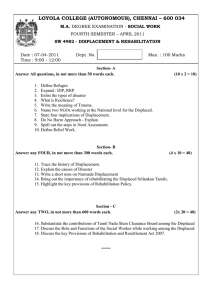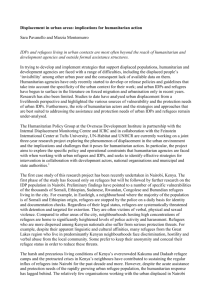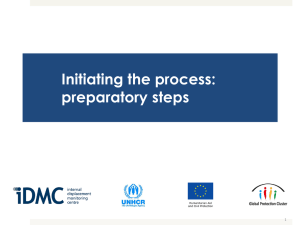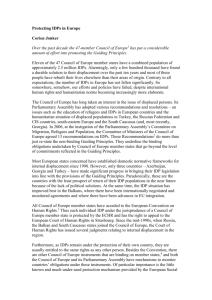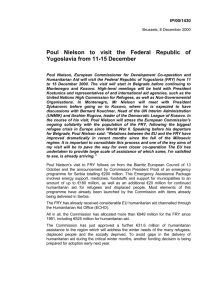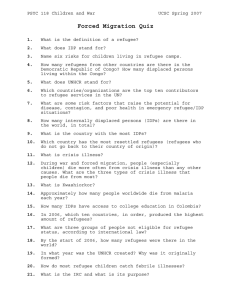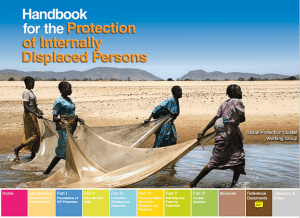High-Level Panel on “Leaving No One Behind: Addressing Forced
advertisement
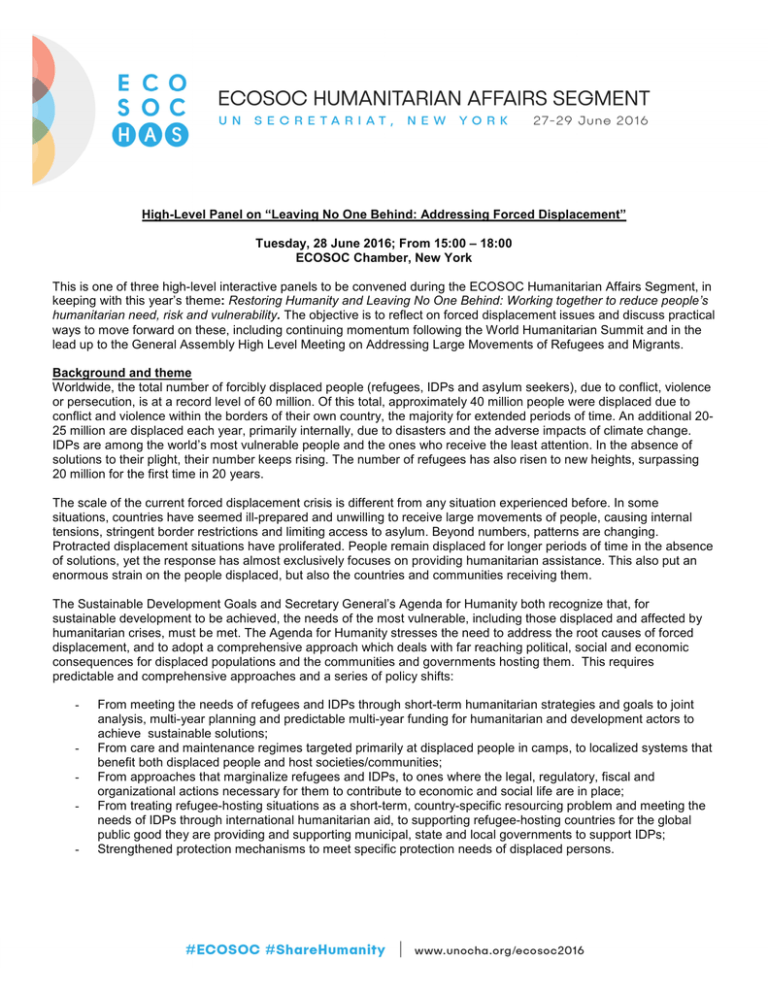
High-Level Panel on “Leaving No One Behind: Addressing Forced Displacement” Tuesday, 28 June 2016; From 15:00 – 18:00 ECOSOC Chamber, New York This is one of three high-level interactive panels to be convened during the ECOSOC Humanitarian Affairs Segment, in keeping with this year’s theme: Restoring Humanity and Leaving No One Behind: Working together to reduce people’s humanitarian need, risk and vulnerability. The objective is to reflect on forced displacement issues and discuss practical ways to move forward on these, including continuing momentum following the World Humanitarian Summit and in the lead up to the General Assembly High Level Meeting on Addressing Large Movements of Refugees and Migrants. Background and theme Worldwide, the total number of forcibly displaced people (refugees, IDPs and asylum seekers), due to conflict, violence or persecution, is at a record level of 60 million. Of this total, approximately 40 million people were displaced due to conflict and violence within the borders of their own country, the majority for extended periods of time. An additional 2025 million are displaced each year, primarily internally, due to disasters and the adverse impacts of climate change. IDPs are among the world’s most vulnerable people and the ones who receive the least attention. In the absence of solutions to their plight, their number keeps rising. The number of refugees has also risen to new heights, surpassing 20 million for the first time in 20 years. The scale of the current forced displacement crisis is different from any situation experienced before. In some situations, countries have seemed ill-prepared and unwilling to receive large movements of people, causing internal tensions, stringent border restrictions and limiting access to asylum. Beyond numbers, patterns are changing. Protracted displacement situations have proliferated. People remain displaced for longer periods of time in the absence of solutions, yet the response has almost exclusively focuses on providing humanitarian assistance. This also put an enormous strain on the people displaced, but also the countries and communities receiving them. The Sustainable Development Goals and Secretary General’s Agenda for Humanity both recognize that, for sustainable development to be achieved, the needs of the most vulnerable, including those displaced and affected by humanitarian crises, must be met. The Agenda for Humanity stresses the need to address the root causes of forced displacement, and to adopt a comprehensive approach which deals with far reaching political, social and economic consequences for displaced populations and the communities and governments hosting them. This requires predictable and comprehensive approaches and a series of policy shifts: - From meeting the needs of refugees and IDPs through short-term humanitarian strategies and goals to joint analysis, multi-year planning and predictable multi-year funding for humanitarian and development actors to achieve sustainable solutions; From care and maintenance regimes targeted primarily at displaced people in camps, to localized systems that benefit both displaced people and host societies/communities; From approaches that marginalize refugees and IDPs, to ones where the legal, regulatory, fiscal and organizational actions necessary for them to contribute to economic and social life are in place; From treating refugee-hosting situations as a short-term, country-specific resourcing problem and meeting the needs of IDPs through international humanitarian aid, to supporting refugee-hosting countries for the global public good they are providing and supporting municipal, state and local governments to support IDPs; Strengthened protection mechanisms to meet specific protection needs of displaced persons. For the millions forced from their homes, whether within their country or across border, adopting such an approach could mean the difference between a continued life of aid dependency and the chance of a better life with dignity and self-reliance. During the WHS High-Level Leaders Round Table on Forced Displacement, representatives of Governments, INGOs, civil society and the private sector resolved to pursue a new approach to address the needs of IDPs and refugees that would meet humanitarian and development needs and enhance the self-reliance of refugees, IDPs and host communities. To bring this vision into action, a number of them pledged to create livelihood and education opportunities for forcibly displaced people and committed more predictable and multi-year funding. In his report on Addressing Large Movements of Refugees and Migrants, the Secretary-General proposed a new Global Compact on responsibility sharing on refugees to step up international support and solidarity with countries receiving large numbers of refugees. During the WHS Round Table on Forced Displacement, there was consensus among participants on the need to better share responsibilities to address large movements of refugees, This high-level panel will discuss these issues and follow-up action to preserve the dignity and improve the lives and self-reliance of forcibly displaced people, including IDPs, and ensure the development of their host communities. Panel members will also discuss how to address root causes of forced displacement, while supporting safe, dignified and durable solutions that measurably reduce forced displacement. Key Issues/Questions Against this backdrop, the High-Level Panel will focus on the following suggested questions to discuss the issue of forced displacement: • What specific measures are needed to build on the commitments to a new approach that not only meets the humanitarian and protection needs of the forcibly displaced but also reduces vulnerability and supports the selfreliance of refugees, IDPs and their hosts? • What initiatives should be supported to ensure the support to durable solutions for refugees and IDPs, including by working towards a substantive reduction of forced displacement, underlining the SecretaryGeneral’s report which calls for the reduction of internal displacement by 50% by 2030. • What planning and financing instruments must be in place to support the new approach to forced displacement, allowing joint analysis and multi-year planning from humanitarian and development actors? • How can the root causes of and the need to focus on prevention of displacement best be addressed? • What practical steps should be taken to advance the Agenda for the Protection of Cross-Border displaced persons in the context of disasters and climate change, which was adopted in conclusion of the Nansen Initiative?
